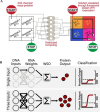Machine Learning and Deep Learning in Synthetic Biology: Key Architectures, Applications, and Challenges
- PMID: 38463314
- PMCID: PMC10918679
- DOI: 10.1021/acsomega.3c05913
Machine Learning and Deep Learning in Synthetic Biology: Key Architectures, Applications, and Challenges
Abstract
Machine learning (ML), particularly deep learning (DL), has made rapid and substantial progress in synthetic biology in recent years. Biotechnological applications of biosystems, including pathways, enzymes, and whole cells, are being probed frequently with time. The intricacy and interconnectedness of biosystems make it challenging to design them with the desired properties. ML and DL have a synergy with synthetic biology. Synthetic biology can be employed to produce large data sets for training models (for instance, by utilizing DNA synthesis), and ML/DL models can be employed to inform design (for example, by generating new parts or advising unrivaled experiments to perform). This potential has recently been brought to light by research at the intersection of engineering biology and ML/DL through achievements like the design of novel biological components, best experimental design, automated analysis of microscopy data, protein structure prediction, and biomolecular implementations of ANNs (Artificial Neural Networks). I have divided this review into three sections. In the first section, I describe predictive potential and basics of ML along with myriad applications in synthetic biology, especially in engineering cells, activity of proteins, and metabolic pathways. In the second section, I describe fundamental DL architectures and their applications in synthetic biology. Finally, I describe different challenges causing hurdles in the progress of ML/DL and synthetic biology along with their solutions.
© 2024 The Author. Published by American Chemical Society.
Conflict of interest statement
The author declares no competing financial interest.
Figures










References
-
- Jumper J.; Evans R.; Pritzel A.; Green T.; Figurnov M.; Ronneberger O.; Tunyasuvunakool K.; Bates R.; Žídek A.; Potapenko A.; Bridgland A.; Meyer C.; Kohl S. A. A.; Ballard A. J.; Cowie A.; Romera-Paredes B.; Nikolov S.; Jain R.; Adler J.; Back T.; Petersen S.; Reiman D.; Clancy E.; Zielinski M.; Steinegger M.; Pacholska M.; Berghammer T.; Bodenstein S.; Silver D.; Vinyals O.; Senior A. W.; Kavukcuoglu K.; Kohli P.; Hassabis D. Highly accurate protein structure prediction with AlphaFold. Nature 2021, 596, 583–589. 10.1038/s41586-021-03819-2. - DOI - PMC - PubMed
Publication types
LinkOut - more resources
Full Text Sources
